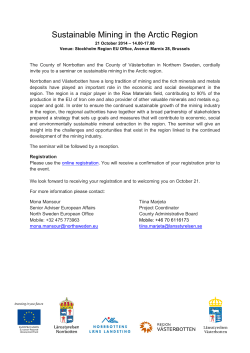
Document 409836
INSIGHTS | P E R S P E C T I V E S ENVIRONMENT AND DEVELOPMENT Brazil’s environmental leadership at risk Mining and dams threaten protected areas By J. Ferreira*, L. E. O. C. Aragão, J. Barlow, P. Barreto, E. Berenguer, M. Bustamante, T. A. Gardner, A. C. Lees, A. Lima, J. Louzada, L. Parry, C. A. Peres, R. Pardini, P. S. Pompeu, M. Tabarelli, J. Zuanon O ver the past two decades, Brazil has emerged as an environmental leader, playing a prominent role in international fora such as the United Nations (UN) Conferences on Sustainable Development. The country has earned praise for the expansion of its protected area (PA) network and reductions in Amazon deforestation. Yet these successes are being compromised by development pressures and shifts in legislation. We highlight POLICY concerns for the newly elected government regarding development of major infrastructure and natural resource extraction projects in PAs and indigenous lands (ILs). Brazil has the largest PA system of any country, covering nearly 2.2 Mkm2 or 12.4% of the global total (1). This network helps conserve some of the most species-rich biomes on Earth and safeguard regionally and globally important ecosystem services [e.g., (2, 3)]. Since 2008, Brazil has lost 12,400 km2 of PAs due to degazetting and 31,700 km2 due to downsizing, with an additional 21,000 km2 threatened by proposals in the National Congress to downsize or degazette reserves in the Brazilian Amazon (4). Until now, unplanned agricultural expansion has been the greatest pressure on the environment, but new pressures are being exerted in response to rising demands for hydropower and mineral resources (see the chart). Hydropower accounts for 77% of Brazil’s energy supply, while 70% national potential, much of which is in the Amazon and Cerrado, remains untapped (5). The Brazilian government predicts that the majority of this latent capacity will need to be exploited by 2030 (5). Mining has grown from 1.6% of gross domestic product in 2000 to 4.1% in 2011; production is expected to further increase by a factor of 3 to 5 by 2030 (6). Brazil has made concerted efforts to create a political and legislative framework supportive of mining and energy sectors. This includes strategic plans and draft legislaSee the supplementary materials for author afliations. *E-mail: joice.ferreira@embrapa.br 706 7 NOVEMBER 2014• VOL 346 ISSUE 6210 tion (PL 1610/96) to develop new mines in sustainable use reserves and ILs (5, 6). Legislation being debated in the Congress (PL 3682/2012) calls for 10% of even strictly protected areas to open for mining concessions, and general prohibition of new PAs in areas of high mineral or hydropower potential. Our analysis indicates that across Brazil there are 1.65 Mkm2 of land with some form of registered mining interest; 1.01 Mkm2 are in Amazonia (chart, A). While relatively few areas have been physically cleared for min- “Brazil’s new government should not squander the country’s hard-won environmental leadership.” ing, at least 20% of all strictly protected areas and ILs overlap with areas registered as under consideration for mining (chart, B), demonstrating the potential for widespread effects if a small fraction is authorized (chart, D and E). In the Amazon alone some 34,117 km2 of strictly protected areas (8.3% of their total area) and 281,443 km2 of ILs (28.4% of the total) lie in areas of registered interest for mining. Few PAs are free from the influence of large hydroelectric dams (chart, C). This analysis raises four key issues. First, the existing PA network plays a critical role in conserving Brazil’s ecosystems, counter to claims that PAs fail to serve their intended function. Second, there is potential for lasting environmental damage from direct, indirect, and cumulative effects associated with many large-scale development projects. Third, environmental mitigation policies are poorly conceived, fall short of international minimum standards for mitigation, and are unlikely to succeed. Finally, systematic inconsistencies and contradictions in the political process, if left unresolved, will undermine the credibility, effectiveness, and transparency of Brazil’s PA system and ILs. Politicians who support industrial development within PAs argue that many PAs only “lock away” mineral reserves and are nothing more than poorly managed “paper parks,” often embroiled in chronic land tenure disputes. Many Brazilian PAs are understaffed, yet there is strong and growing evidence of their key role in conserving Brazilian ecosystems. For instance, the probability of deforestation 7 to 10 times lower in Amazonian PAs than in surrounding areas (7). The limited PA network in the Cerrado biome has reduced conversion to other land uses. Environmental effects of large-scale mining and hydropower within PAs are likely to be multiple and severe. Localized, direct effects can be particularly destructive within hyperfragmented Cerrado and Atlantic Forest biomes, where further loss or degradation of native vegetation could undermine opportunities to restore ecological connectivity and prevent extinctions (8). Yet direct local effects of development within PAs may be eclipsed by indirect environmental effects likely to ensue in surrounding regions over decadal time scales, such as increased deforestation, illegal logging, overhunting, and forest fires. Current proposals (e.g., PL 3682/2012) for mitigating environmental damage caused by extractive activities within PAs are inadequate, poorly conceived, and fail to meet international best-practice standards prescribed by the basic mitigation hierarchy: avoid; minimize; mitigate; offset [for example, (9)]. In presuming that extraction can be authorized within PAs, the first mitigation option—avoid effects—is discarded. The assumption that there are no “no-go” areas for development could result in irreversible environmental damage. Mitigation actions can provide substantial conservation benefits relative to a businessas-usual “no mitigation” development scenario (10). But mitigation actions for large development projects in Brazil are rarely designed before project approval and initiation and may never be implemented (11). Restoration is often viewed as a magic wand, yet there is little evidence that we can restore complex natural ecosystems after large-scale mining (12). Mitigation and restoration efforts rarely address indirect and cumulative effects. Recognizing that environmental effects cannot be fully mitigated on-site, proposed legislation to open up to 10% of strictly protected areas for mining recommends that offset areas be twice the size of affected areas (PL 3682/2012). Applying biodiversity offsets here is, at best, inappropriate. Although a case can be made to use offsets to enhance protection of threatened PAs to compensate for environmental damage elsewhere, it is counterintuitive to expect that protection elsewhere can compensate, on an ecological sciencemag.org SCIENCE A B C Indigenous lands Strictly protected lands N 0° 10°S E Strictly protected 200,000 80 300 25,000 250 20,000 200 15,000 150 150,000 60 100 100,000 40 50 50,000 Am az on ia Ca at in ga Ce rr At ad la o nt ic fo re st Pa m pa Pa nt an al 0 Biomes 0 500,000 300,000 95.9 999 0.2 0.0 762 0.1 2.3 0.0 0.0 0.0 20 200,000 100,000 0 50°W 40°W 20,000 18,000 16,000 14,000 12,000 105,495 10,000 295,418 8,101 8,000 209,208 5,764 3,069 6,000 4,000 20,801 1,214 4,467 2,000 125 0 400,000 Am az on ia Ca at in ga Ce r ra At do la nt ic fo re st Pa m pa Pa nt an al Area (km2) 0 0.1 0.0 Under consideration Approved 281,443 135 160 Approved but not yet under construction No protection 600,000 30,000 1.0 1.2 F Indigenous land 100 300,000 816 47.9 60°W 250,000 350 344 23.3 70°W 120 350,000 5,000 40°W 800,000 691,433 18,001 700,000 400 10,000 50°W 1.500 0 at in ga Ce r ra At do la nt ic fo re st Pa m pa 1,320 359 40,000 34,117 276 35,000 60°W 750 Under construction Biomes Area (km2) 70°W 0 1.125 Operational status Operating Pa nt an al 40°W km 375 >75 a 50°W 35–50 Hydroelectric dams energy production (kw) 30,000 30,001–252,000 252,001–300,000 300,001–370,000 370,001–820,000 1,820,000–11,250,000 Ca D 60°W 0.5 0.5–5 05–10 10–35 Am az on i 70°W Under consideration 30°S Approved 20°S Percent of each protected area covered by mining areas Unprotected areas Under consideration Approved Mining areas overlapping indigenous lands No overlap Under consideration Approved Overlap with mining strictly protected areas No overlap Under consideration Approved Biomes Distribution of municipal, state, and federal strictly protected areas, ILs, approved mining concessions, areas of registered mining interest, and approved hydroelectric dams in Brazil (A and C). Areas officially approved as mining concessions and publicly registered as under consideration for extraction are compared against the distribution of all strictly protected areas (D), ILs (E), and unprotected areas (F), in addition to the percentage of overlap between all protected areas and approved mining concessions and areas of registered mining interest (B). See the supplementary materials for details. like-for-like basis, for effects on PAs. PAs established in part on criteria of vulnerability and irreplaceability may be too risky or impossible to offset (14), as is increasingly the case in the most deforested areas of Brazil. In addition, such offsets are designed to target only direct, not indirect and cumulative, effects. Brazil’s National System of Protected Areas was established in 2000 after more than a decade of debate in the Congress, building on public consultation across society and academia and representing a major contribution toward Brazil’s international environmental commitments, including UN Conventions on Biological Diversity and Climate Change. In contrast, the process of dismantling PAs to allow industrial development has paid little regard to criticism from Brazilian society, exemplified by a recent campaign in defense of Brazilian PAs by the federal Public Prosecutor’s Office. To be credible and fair, any attempt to change and downgrade this legislation should involve the same level of public consultation and democratic due process. Beyond conservation and stewardship of its own biodiversity and environmental reSCIENCE sciencemag.org sources, Brazil has a vital role in motivating and supporting adoption of more sustainable development trajectories around the world. Yet, the integrity of Brazil’s ecosystems and the credibility of its environmental leadership are jeopardized by recent shifts toward weaker and poorly negotiated environmental safeguards in the national PA system and ILs. This is consistent with recent changes in Brazil’s Forest Code which include an amnesty for large areas that were illegally deforested in the past (14). Although there are often strong economic and ethical arguments for development, Brazil should not squander its hard-won record of success and leadership in favor of fast-tracking short-lived development projects that leave a long legacy of environmental damage. We call on Brazil’s newly elected government to ensure that individual development initiatives are subject to a comprehensive, socially inclusive, and long-term cost-benefit analysis that allows for any new proposal to be compared against possible alternatives and that takes full account of environmental and social effects, including rights of traditional and indigenous peoples. ■ REFERENCES 1. WDPA, 2012. World Database on Protected Areas. Database accessed in June 2014 from www.protectedplanet.net. 2. A. Veríssimo et al., “Protected areas in the Brazilian Amazon: Challenges and Opportunities” (Imazon, Belém, Brazil; Instituto Socioambiental (ISA), Sao Paulo, Brazil, 2011) 3. D. V. Spracklen et al., Nature 489, 282 (2012). 4. E. Bernard et al., Conserv. Biol. 28, 939 (2014). 5. Brasil Ministério de Minas e Energia (MME), Plano Nacional de Energia 2030 (MME, Rio de Janeiro, 2007). 6. Brasil Ministério de Minas e Energia (MME), Plano Nacional de Mineração 2030 (MME, Rio de Janeiro, 2010). 7. T. H. Ricketts et al., PLOS Biol. 8, e1000331 (2010). 8. F. P. L. Melo et al., Trends Ecol. Evol. 28, 462 (2013). 9. Business and Biodiversity Offsets Programme (BBOP), Guidance Notes to the Standard on Biodiversity Offsets (BBOP, Forest Trends, Washington, DC, 2012). 10. A. Villarroya et al., PLOS ONE 9, e107144 (2014). 11. P. M. Fearnside, Environ. Sci. Policy 38, 164 (2014). 12. M. Maron et al., Biol. Conserv. 155, 141 (2012). 13. J. D. Pilgrim et al., Conserv. Lett. 6, 376 (2013). 14. B. Soares-Filho et al., Science 344, 363 (2014). ACKNOWL EDGMENTS The following authors thank the following grants for support: L.E.O.C.A. (CNPq 304425/2013-3), T.A.G. (Formas 2013-1571), R.P. (CNPq 306715/2011-2), J.B. (CNPq 400640/2012-0), and E.B. (NE/K016431/1). SUPPLEMENTARY MATERIALS www.sciencemag.org/content/346/6210/706/suppl/DC1 10.1126/science.1260194 7 NOVEMBER 2014• VOL 346 ISSUE 6210 707
© Copyright 2025













